 | |
| Rules required | Dungeons & Dragons, 3rd edition |
|---|---|
| Character levels | 10th |
| Authors | Steve Miller and Sean K Reynolds |
| First published | 2000 |
Into the Dragon's Lair is an adventure module for the 3rd edition of the Dungeons & Dragons fantasy role-playing game.
 | |
| Rules required | Dungeons & Dragons, 3rd edition |
|---|---|
| Character levels | 10th |
| Authors | Steve Miller and Sean K Reynolds |
| First published | 2000 |
Into the Dragon's Lair is an adventure module for the 3rd edition of the Dungeons & Dragons fantasy role-playing game.
Into the Dragon's Lair takes place in the Forgotten Realms setting, and takes place after the novels The High Road and The Death of a Dragon by Troy Denning. The nation of Cormyr tries to rebuild after the death of King Azoun IV, and seeks the treasure hoard of a dragon to fund these efforts and keep the kingdom from falling into chaos. The player characters must find this treasure before all the other seekers.
Into the Dragon's Lair was published in October 2000, and was written by Steve Miller and Sean K Reynolds. [1] Cover art was by Paul Bonner and interior art by Michael Collins.
The reviewer from Pyramid suggested that "for the most part it's a standard hunt for treasure", but commented: "While sounding simple, during the course of the adventure, the players must deal with not one, but two rival groups of adventurers." [2]
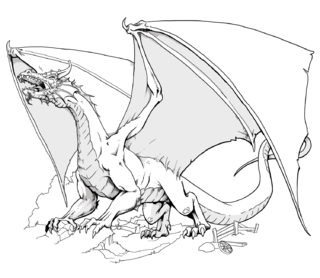
In the Dungeons & Dragons (D&D) fantasy role-playing game, dragons are an iconic type of monstrous creature. As a group, D&D dragons are loosely based on dragons from a wide range of fictional and mythological sources. Dungeons & Dragons allows players to fight the fictional dragons in the game and "slay their psychic dragons" as well. These dragons, specifically their "dungeon ecology", have implications for the literary theory of fantasy writing. D&D dragons also featured as targets of the moral panic surrounding the game.
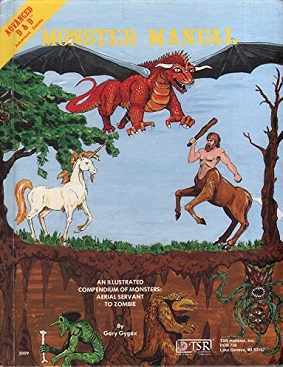
The Monster Manual is the primary bestiary sourcebook for monsters in the Dungeons & Dragons fantasy role-playing game, first published in 1977 by TSR. The Monster Manual was the first hardcover D&D book and includes monsters derived from mythology and folklore, as well as creatures created specifically for D&D. Creature descriptions include game-specific statistics, a brief description of its habits and habitats, and typically an image of the creature. Along with the Player's Handbook and Dungeon Master's Guide, the Monster Manual is one of the three "core rulebooks" in most editions of the D&D game. As such, new editions of the Monster Manual have been released for each edition of D&D. Due to the level of detail and illustration included in the 1977 release, the book was cited as a pivotal example of a new style of wargame books. Future editions would draw on various sources and act as a compendium of published monsters.
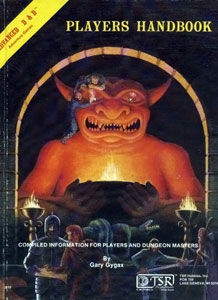
The Player's Handbook is the name given to one of the core rulebooks in every edition of the fantasy role-playing game Dungeons & Dragons (D&D). It does not contain the complete set of rules for the game, and only includes rules for use by players of the game. Additional rules, for use by Dungeon Masters (DMs), who referee the game, can be found in the Dungeon Master's Guide. Many optional rules, such as those governing extremely high-level players, and some of the more obscure spells, are found in other sources.

The Dungeon Master's Guide is a book of rules for the fantasy role-playing game Dungeons & Dragons. The Dungeon Master's Guide contains rules concerning the arbitration and administration of a game, and is intended for use by the game's Dungeon Master.

Oriental Adventures is the title shared by two hardback rulebooks published for different versions of the Dungeons & Dragons (D&D) fantasy roleplaying game. Each version of Oriental Adventures provides rules for adapting its respective version of D&D for use in campaign settings based on the Far East, rather than the medieval Europe-setting assumed by most D&D books. Both versions of Oriental Adventures include example campaign settings.

Dragon's Lair II: Time Warp is a 1990 laserdisc video game by the Leland Corporation. It is the first true sequel to Dragon's Lair. As with the original, Dragon's Lair II: Time Warp consists of an animated short film that requires the player to move the joystick or press a fire button at certain times in order to continue. It takes place years after the original Dragon's Lair. Dirk has married Daphne, and the marriage has produced many children. When Daphne is kidnapped by the evil wizard Mordroc in order to be forced into marriage, Dirk's children and his mother-in-law are clearly upset by the abduction of Daphne, and Dirk must once again save her.
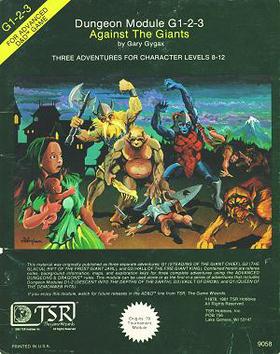
Against the Giants is an adventure module written by Gary Gygax and published by TSR in 1981 for the Dungeons & Dragons fantasy role-playing game. It combines the G series of modules previously published in 1978: Steading of the Hill Giant Chief, Glacial Rift of the Frost Giant Jarl, and Hall of the Fire Giant King. All three were produced for use with the 1st edition Advanced Dungeons & Dragons rules. In 1999, to recognize the 25th anniversary of TSR, the company released an updated version, Against the Giants: The Liberation of Geoff. Later in 1999, Wizards of the Coast published a novelization of Against the Giants by Ru Emerson.

The Hidden Shrine of Tamoachan is an adventure module for the Dungeons & Dragons (D&D) fantasy role-playing game, set in the World of Greyhawk campaign setting for use with the 1st edition Advanced Dungeons & Dragons rules. It is the first in the C-series of modules, a set of unrelated adventures originally designed for competitive play, with the C representing the first letter in the word competition. It is the first D&D adventure to use boxed, "read aloud" text.
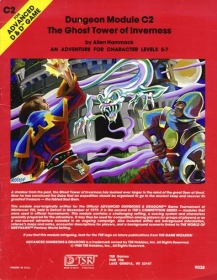
The Ghost Tower of Inverness is an adventure module for the Dungeons & Dragons fantasy roleplaying game, set in the game's World of Greyhawk campaign setting. The module's title refers to an ancient magical tower located in the southern Abbor-Alz Hills. The "C" in the module code represents the first letter in the word "competition," the name of C1 – C6 module series.

The Forgotten Temple of Tharizdun is an adventure module for the Dungeons & Dragons (D&D) role-playing game, for use in the World of Greyhawk campaign setting. The module was published by TSR, Inc. in 1982 for the first edition Advanced Dungeons & Dragons rules.
The Draconomicon is the title for several optional sourcebooks for the Dungeons & Dragons role-playing game, providing supplementary game mechanics for dragons specifically. Different Draconomicon books have been issued for the 2nd, 3rd, and 4th editions of the Dungeons & Dragons game. The Latin-inspired name of the books loosely translates as "Book of Dragon Names".
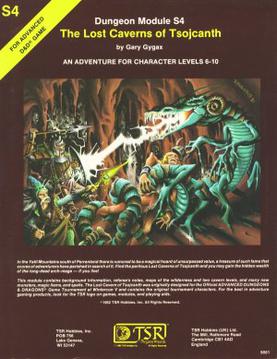
The Lost Caverns of Tsojcanth is an adventure module for the Dungeons & Dragons fantasy role-playing game. It was written by Gary Gygax and published by TSR in 1982 for the first edition Advanced Dungeons & Dragons (AD&D) rules. The 64-page adventure bears the code "S4" and is set in the Greyhawk campaign setting. It is divided into two parts, a 32-page adventure, and a 32-page booklet of monsters and magic items. The plot involves the player characters investigating rumors of lost treasure. After traversing a wilderness and two levels of dungeons, the players face Drelnza, the vampiric daughter of long-deceased archmage Iggwilv.
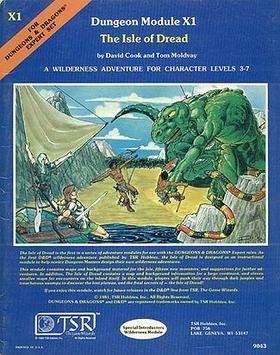
The Isle of Dread is an adventure for the Dungeons & Dragons role-playing game. The adventure, module code X1, was originally published in 1981. Written by David "Zeb" Cook and Tom Moldvay, it is among the most widely circulated of all Dungeons & Dragons adventures due to its inclusion as part of the D&D Expert Set. In the adventure, the player characters search for a lost treasure, journey to the prehistoric Isle of Dread, and there meet new nonhuman races.
The Wheel of Time Roleplaying Game is a role-playing game based on The Wheel of Time, an epic fantasy series by American author Robert Jordan.

Book of Challenges is a supplemental rulebook for the 3rd edition of the Dungeons & Dragons role-playing game that presents a number of ready-made dungeon encounters that a Dungeon Master can insert into a scenario.
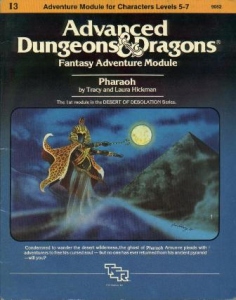
Desert of Desolation is a compilation adventure module published by TSR for the Dungeons & Dragons (D&D) fantasy roleplaying game. It combines three previously published individual modules: Pharaoh, Oasis of the White Palm, and Lost Tomb of Martek. The modules were made for use with the first edition Advanced Dungeons & Dragons (AD&D) rules. Pharaoh was created by Tracy and Laura Hickman soon after the couple married in 1977, and published by TSR in 1982. Oasis of the White Palm was a collaboration between Tracy Hickman and Philip Meyers, and Hickman wrote the Lost Tomb of Martek on his own; both were printed in 1983.
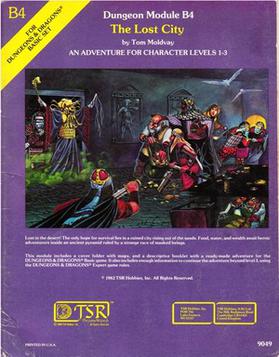
The Lost City (B4) is a Dungeons & Dragons adventure module by Tom Moldvay. It was first published by TSR in 1982 and was designed as a stand-alone adventure for use with the Dungeons & Dragons Basic Set. The working title for the module was "The Lost City of Cynidicea". Moldvay designed the module as a low-level scenario to give novice Dungeon Masters experience in fleshing out adventures such that it is only partially complete. The plot involves the player characters discovering a ruined subterranean city slowly rising out of the sands. The adventure is set inside a huge step pyramid, with the lower pyramid only sketched out and the city itself described with a list of the major areas and a map. The adventure's main villain is Zargon, a giant one-eyed monster and his minions. The entire double pyramid, not including the city, contains over 100 rooms.

Fantastic Locations: Dragondown Grotto is a generic setting adventure module for the 3.5 edition of the Dungeons & Dragons roleplaying game. The adventure is designed for 10th level characters. It contains a 16-page adventure as well as two poster sized double-sided maps for use in miniatures play.

The Speaker in Dreams is an adventure module for the 3rd edition of the Dungeons & Dragons fantasy role-playing game.

Keep on the Shadowfell is the first official product from the 4th edition Dungeons & Dragons ("D&D") line. It is part one of a three-part series of adventures. It introduces a series of 4th edition Dungeons & Dragons settings called the Points of Light, a loosely connected and open-ended series of settings designed to allow other modules and fan-created content to be integrated seamlessly into the settings' largely unmapped fantasy world or the Dungeon Master's own custom-made setting. The adventure, written by Mike Mearls and Bruce R. Cordell, was published in 2008 by Wizards of the Coast. It is followed by the sequels Thunderspire Labyrinth and Pyramid of Shadows. The adventure is designed for characters from levels 1 to 3. Its module code, "H", stands for Heroic Tier. This module is set in a region of the world called the Nentir Vale, which is described in greater detail in the 4th edition Dungeon Master's Guide.